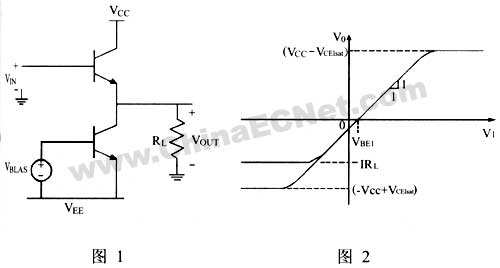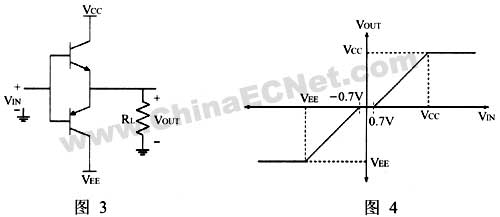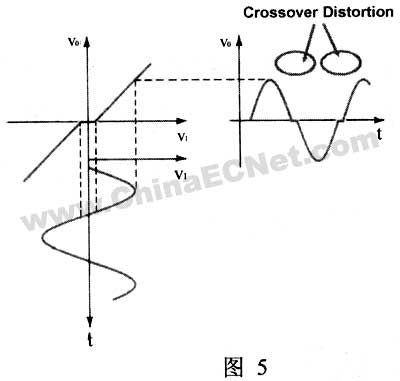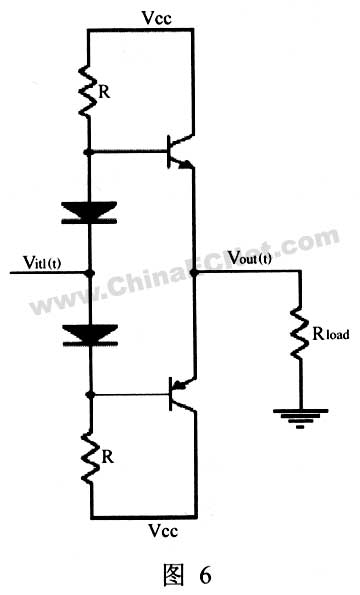Because consumers demand smaller shapes and longer battery life for mobile and portable devices, designers are looking to replace common linear amplifiers with high-efficiency devices. While Class AB amplifiers have dominated the audio world for quite some time, Class D amplifiers provide a balance between required efficiency and distortion.
This article refers to the address: http://
Class A amplifier
Class A amplifiers (Figure 1) use the same transistors for the two half cycles of the audio waveform. In this configuration, the output transistor always has a current through, and even if there is no input signal, the output transistor does not turn off, and the DC current through the transistor. Pure Class A amplifiers are very inefficient and generate a lot of heat even without audio output. The current flowing through the output transistor is comparable to the drive current through the speaker load at full power. Many people think that Class A amplifiers sound better than Other types of amplifiers, which may be correct in some ways.
 |

Class A amplifiers are characterized by high fidelity and low efficiency. Fidelity means that in addition to the amplitude, the output signals are very similar in all respects to the input signal, ie they have the same form and frequency. In some cases, there may be a phase difference (typically 180o) between the output signal and the input signal, but the source signal can still be reproduced very well. If the output signal differs from the input signal in form or frequency, the signal is distorted. Distortion is an undesired signal change between input and output.
Class B amplifier
Class B amplifiers (Figure 3) are amplified using different transistors for each half of the waveform. Pure Class B amplifiers are generally not used in the audio field. In a Class B amplifier, a small portion of the waveform is distorted. We know that to turn on a bipolar transistor, a voltage of about 0.7V is applied across the base to the emitter. In a pure Class B amplifier, the output transistors are not biased in an ON state. This means that the portion of the waveform that is in the 0.7V window will not be accurately magnified. The output transistors of each half cycle (positive half cycle and negative half cycle) of the waveform have a 0.7V non-conduction region (Figure 4). The distortion portion of the waveform is called crossover distortion. This distortion in the signal is undesirable (compared to the source signal). Figure 5 shows the shape of the crossover distortion.
 |

Class B amplifiers are twice as efficient as Class A amplifiers because the amplifier components turn on only half of the input signal (and consume power).
 |
Class AB amplifier
Class A amplifiers are inefficient and are not conducive to energy savings. Class B amplifiers can cause signal distortion and are not suitable for audio amplifiers. Class AB amplifiers (Figure 6) are the best compromise. Class AB amplifiers are Class B amplifiers that have a constant small bias current flowing through the output transistors. This eliminates crossover distortion. Since the output transistor is always on (even when there is no audio input signal), there is always a small amount of bias current flowing through. Unlike pure Class A amplifiers, the amount of current varies. The output transistors of a pure Class A amplifier also carry a large amount of current when there is no audio signal. The output transistor of a pure Class B amplifier has no current through when there is no input signal.
 |
Class AB amplifiers are much more efficient than Class A amplifiers and have no distortion problems with Class B amplifiers. Class AB amplifiers can be as efficient as 65%.
Class D amplifier
This is a switched amplifier consisting of an H-bridge and a load (Figure 7). The load includes speaker impedance and a passive filter. The H-bridge controls the current through the speaker and the LC filter filters the switching noise. To better explain why this approach is more suitable for mobile or portable devices than traditional linear amplifiers, we must look at the pros and cons of the various structures.
 |
National Semiconductor's filterless Class D amplifier, the LM4667 (Figure 8), is a fully differential input and output, replacing the LC output filter with an innovative modulator. Since the output filter is saved, the number of components is reduced, the circuit design is simplified, and the board area is reduced. The LM4667 uses Delta-sigma modulation to process analog input signals, reducing output noise and THD compared to traditional pulse width modulation.
 |
Advantages of Delta-sigma modulation
The linearity of Delta-Sigma modulation is better than PWM (Pulse Width Modulation), which also improves noise floor and THD+N performance.
Class AB amplifier and class D amplifier efficiency comparison
Figure 9 shows the efficiency comparison curve. The upper curve is the efficiency of the Class D amplifier and the lower curve is the efficiency of the Class AB amplifier. It can be seen that the efficiency of the two is very close at full power output (about 65% for class AB and about 88% for class D), only 23% difference, but in practical applications, the output of the amplifier is 1/3 of the time. At 1/2 power, Class AB amplifiers are only 30-40% efficient, while Class D amplifiers are more than 80%. The huge efficiency (more than 40%) means useless power (heat generation) and reduced battery life.
 |
to sum up
Class A amplifiers are inefficient but have high fidelity.
Class B amplifiers are generally not used in the audio field because crossover distortion occurs in a small portion of the Class B amplifier waveform. Waveforms that fall into the 0.6V window cannot be accurately scaled up.
Class AB amplifiers are much more efficient than Class A amplifiers and have no distortion problems with Class B amplifiers.
Class D amplifiers are very efficient. Increased efficiency translates into lower system cost, lower operating temperature, lower supply voltage, and lower power consumption. The actual operating efficiency of Class AB amplifiers is between 30-40%, while the efficiency of Class D amplifiers can easily reach 80%.
Ceramic element( Self drive)
Piezo Ceramic Disc,Piezoelectric Ceramic,Piezo Element
SWT Smart Technology Co., Ltd. , http://www.fuding-sound.com